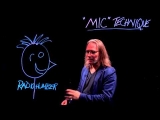Generation Loss.m4v
: generation, loss
Generation Loss.m4v
With today’s digital files, people make copies of copies with no noticeable loss of quality. With digital, instead of calling the copy a “dub”, it’s generally called a “clone”. However, that was not the case with analog equipment. Every time analog material was copied it was one generation worse than the tape or vinyl disc that it was copied from, meaning that it had all of the flaws and issues of the original, plus increased wow and flutter, and a reduced signal-to-noise was an issue for people like Les Paul, when he overdubbed using his sound-on-sound technique, since each subsequent pass meant that the tape was one generation worse than the previous pass. Multi-track eliminated most generation losses, since material was recorded on a separate track, where it usually remained as first-generation until the remix. However, often when the tape was getting too full, some tracks would be premixed and bounced to other tracks on the multi-track in order to open up tracks for more recording. Those predubbed tracks were a generation down from the original. When the entire session would then be remixed, usually to a stereo analog master, that mix would be one generation down from the multi-track. And if a safety copy were made from the stereo master, that tape would be even one more generation removed from the engineers were skillful in preserving a good signal-to-noise ratio through many generations, but they always would prefer to work with first generation material whenever possible.















